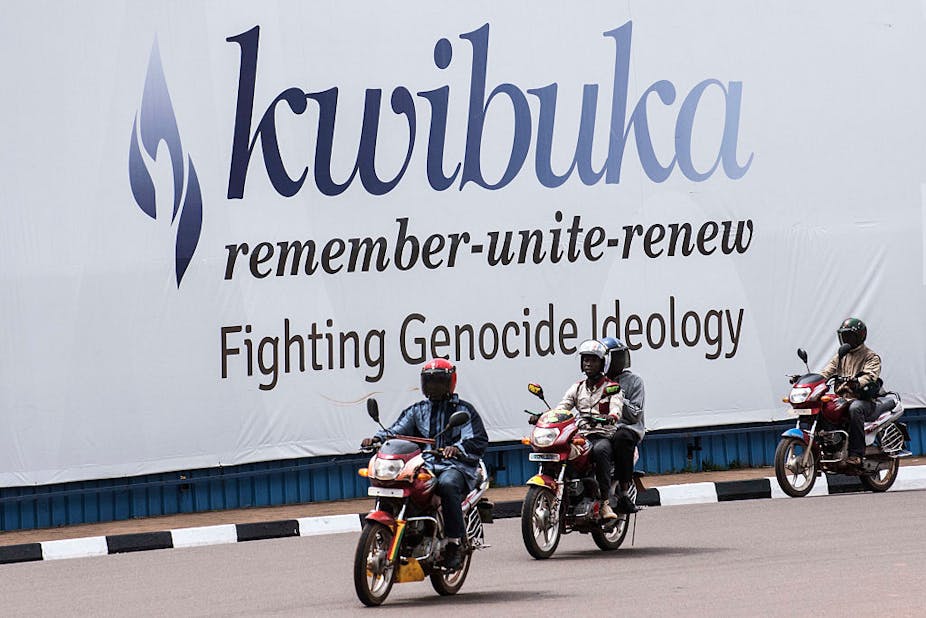Each year, Rwandans at home and in the diaspora remember those killed in the 1994 genocide. This is not a single-day event. Kwibuka (“to remember” in the local Kinyarwanda language) consists of 100 days of official commemoration. It’s characterised by explicit acknowledgement and public discussions of ethnic identity.
But there’s a puzzling contradiction of state policy at play during Kwibuka.
In 2003, Rwanda adopted a policy of ethnic non-recognition. There are no Hutus or Tutsis; only Rwandans. The aim is to achieve national homogeneity in a country that was torn apart by ethnic genocide.
The policy is strictly enforced, but relaxes during the 100 days of Kwibuka.
This has led to seemingly opposed practices: legally erasing identity groups because of their link to conflict, contrasted against three months of saturated reminders in the form of public speeches, memorial programming, burials and commemorative signage.
In 2014, 20 years on, the genocide was officially renamed from the Rwandan genocide to “the 1994 Genocide Against the Tutsi”. This decision was recognised by the United Nations General Assembly in 2018.
The change marked a distinct shift from an inclusive naming. It also centred Tutsi people as the sole targets of genocidal violence. This, despite Rwanda and the international community historically acknowledging that moderate Hutus were victimised, too.
Read more: In Rwanda, genocide commemorations are infused with political and diplomatic agendas
My research pinpointed four anomalies that were not present during the rest of the year but emerged during Kwibuka:
- a perceived increase in violence towards survivors
- an increase in accusations and convictions of genocide ideology and denial
- widespread youth involvement in identity rhetoric
- a reported increase in prisoner confessions.
These anomalies highlight how Kwibuka exacerbates social tensions. My research was done five years ago, but the anomalies I observed persist.
Studying state-led commemoration
In my research, I examined the rhetoric coming from the Rwandan state on the 1994 genocide. I also observed nine commemoration events to see how attendees reacted to and spoke about Kwibuka.
I additionally conducted interviews to help me understand the differences between the commemoration period and the rest of the year.
I was curious to follow what effect this sudden shift from ethnic non-recognition to recognition might have on people.
In the aftermath of the genocide, the Rwandan Patriotic Front, the country’s leading political party, has “positioned itself as the only guarantor of peace, security and development”, as Rwandan lawyer Louis Gitinywa writes.
My research shows this message is reinforced through commemoration programming. This commonly emphasises that only the ruling party and current political leadership stand between ordinary Rwandans and a reemergence of genocidal violence.
The ethnic non-recognition policy is linked to Rwandan laws against “genocide ideology” and “sectarianism”. The government claims that such laws keep Rwandans safe. However, critics point out their chilling effect on legitimate political opposition and dissent. I was at times told that simply asking questions about genocide commemoration and ethnicity could be seen as being at odds with the law.
Read more: Commonwealth leaders gather in Rwanda as UK refugee plan focuses attention on human rights
Anomalies
I discovered four anomalies that are only present during the commemoration period.
First, there is heightened sensitivity across the country. Survivors told me they were worried about violence against them and their property. This is not baseless. National radio and television stations report threats against survivors throughout Kwibuka. These include their livestock being tortured, property destroyed and bones mailed to memorial sites.
The second anomaly is the emergence of “survivor youth” and their engagement with ethnic rhetoric. Among my interviewees, “survivor” was synonymous with “Tutsi”.
This self-claimed identity held even among young people who have spent most of their lives in a country with an ethnic non-recognition policy. Notably, my youth interviewees identified themselves by ethnicity unprompted, and when asked if they knew any non-Tutsi who would refer to themselves as “survivors”, they all said no or were unsure.
The National Commission for the Fight Against Genocide shared data with me on accusations and convictions related to genocide denial and ideology during Kwibuka. It showed that many of these cases involved people born well after 1994. This happened despite the state’s insistence that the next generation is free of the old biases or violent inclinations that drove the genocide.
The third anomaly is the increase in accusations and convictions of genocide ideology, denial and sectarianism. My interview data was consistent with statistics from the Rwanda Investigation Board showing that such accusations and convictions are concentrated during Kwibuka. It’s not clear why, but heightened sensitivity and the fear rhetoric promoted by the Rwandan Patriotic Front during the 100 days may be among the reasons.
Finally, Kwibuka always marks an increase in confessions from imprisoned génocidaires. This relates directly to an increase in bodies of genocide victims being discovered. Confessions are made each year, even though authorities say incentives for prisoners who share information ended some time ago.
I have argued that this continual discovery of bodies merits further attention. Exhumation and reburial can lead to closure for families and communities, and is an important part of commemoration. However, a claim that prisoners confess because they are “moved by the spirit of Kwibuka” is at odds with documented coercion and human rights violations in Rwandan prisons.
Read more: Rwandans discuss how best to commemorate genocide
Memory without exclusion
My research in no way aims to promote covering up history. But there is a difference between teaching history and stoking historical social divisions. The exclusionary “us versus them” form of nationalism that emerges during Kwibuka may threaten Rwanda’s precarious peace.
One solution may lie in the fact that the commemoration period is highly mutable. It adapts and changes every year. This means it’s possible to have more inclusive events that favour a balance between official narratives and ordinary people’s memories.

